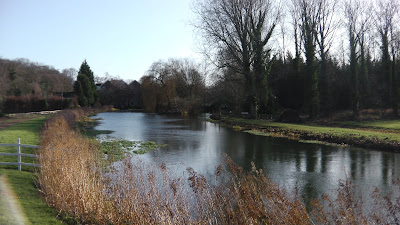Recently I spent the day with the Wherry Yacht Charter Charitable Trust in Wroxham. I went there to film "Norada" being hauled onto the new slipway for some dry dock maintenance before she goes out on charter. The equipment to winch "Norada" onto the new slipway had been tested and trialed but this was the the first time it had been used for real. The wherry yacht was winched out of the water just far enough to attach the A-frame and the air jacks. Then slowly but surely "Norada" was inched majestically up the slipway - fascinating!
I have a limited knowledge of boats and their design so it was curiosity that drove me to research "Norada's" pedigree.
There is a theory that the elegant lines of the old trading wherries can be traced back to the Viking long ships. True or not, there is no doubt that the graceful profile of a trading wherry is very pleasing to the eye. When freight shifted from the river to the railway many trading wherries were converted to pleasure wherries. Then, as tourism on the broads grew in popularity, purpose built pleasure wherries were turned out of the yards to meet the growing demand. The ultimate development of the pleasure wherries led to the emergence of the lighter and faster Wherry yachts. "Luxury afloat" was unashamedly built into these hire craft and the Edwardians loved them.
I have a limited knowledge of boats and their design so it was curiosity that drove me to research "Norada's" pedigree.
There is a theory that the elegant lines of the old trading wherries can be traced back to the Viking long ships. True or not, there is no doubt that the graceful profile of a trading wherry is very pleasing to the eye. When freight shifted from the river to the railway many trading wherries were converted to pleasure wherries. Then, as tourism on the broads grew in popularity, purpose built pleasure wherries were turned out of the yards to meet the growing demand. The ultimate development of the pleasure wherries led to the emergence of the lighter and faster Wherry yachts. "Luxury afloat" was unashamedly built into these hire craft and the Edwardians loved them.
"Norada"
is one of three wherry yachts currently operated by the WYCCT, her sisters are "Olive" and "White Moth". All three
of these vessels were built by Ernest Collins of Wroxham. The origin
of these elegant craft is a fascinating story in its own right.
 |
| Wherry Yacht "White Moth" |
(photograph courtesy of Katy Walters )
In
late summer 1903, the beach yawl "New Skylark" was carrying thirteen
passengers on a pleasure trip from the beach at Great Yarmouth. About a
mile out she collided with the F E Webb, a steamer out of London. The
"New Skylark" was practically cut in half and sank instantly with the
loss of six souls.
Almost
a week after the accident the wreckage of the "New Skylark" was
recovered and towed into Yarmouth harbour. Ernest Collins learned of
the "New Skylark" and bought the wreck. He redesigned her
with cabin accommodation for ten adults and added a counter stern. With a
gaff and boom rig she was re-launched as the wherry yacht “White
Heather”. "White Heather" could be hired for around ten pounds per week including a skipper and an attendant, she continued working as a hire craft until 1932.
In
1909 Ernest Collins built "Olive" a dedicated wherry yacht naming the vessel after his youngest daughter. The interior layout used
in "White Heather" had been so successful it was replicated in
"Olive". "Olive" weighed in at twenty one tons with a draught of
three feet six inches. She could only squeeze under Potter Heigham
bridge if tidal conditions were perfect, and passing under the old
Ludham bridge was out of the question.
Next came "Norada"
she was named after the nineteen metre class, racing yacht of the same
era. "Norada" was launched in 1912, the same year as "Titanic". However the the
wherry yacht proved to be infinitely more durable than the ill fated
liner. "Norada" weighing just sixteen tons was shorter than "Olive" by three feet, and twenty one
inches narrower in the beam. She was designed specifically to pass under the "Old"
Ludham bridge by virtue of a lower cabin than her sister "Olive" "Norada's" reduced dimensions would also allow her to sail freely and
unhindered through the locks on the Upper Bure and the Ant. Ironically many of the locks and bridges were washed away in the great flood the same year she was launched.
 |
| Racing Yachts circa 1900. |
"Norada" continued working as a hire craft until 1950 when necessary economies to the Collins hire fleet led to her being sold into private ownership, her new owner renamed her "Lady Edith". Then in 1964 Barney Matthews, once a skipper for Ernest Collins, bought and restored the wherry yacht. In her seventy-fifth year she was once again named "Norada".
2012 is "Norada's" centenary year - watch out for this spirit of the Edwardian age sailing on the Norfolk and Suffolk waterways this summer.
If you would like to see a short video of "Norada" being "hauled out" click here.
If you would like to see a short video of "Norada" being "hauled out" click here.



































